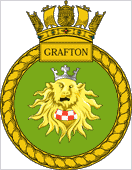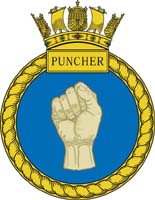|
 Today,
every ship, submarine, shore establishment and Naval Air Squadron
has it’s own unique badge. A ship’s badge, not crest as they
are often incorrectly referred to, and their name represents a
piece of history in that it is not the first time that the badge
or name would have appeared on a Royal Navy ship or submarine. For
as long as there has been a navy ships have been named after other
ships that previously existed. The Trafalgar class submarine HMS
Turbulent for instance is the fifth unit to bare the name
Turbulent. Ships names are usually allocated to the same class of
ship, a good example of this is the name HMS Ark Royal that apart
from the first that was 690 tonne 38 gun ship built for Sir Walter
Raleigh all of the subsequent five have been aircraft carriers. Today,
every ship, submarine, shore establishment and Naval Air Squadron
has it’s own unique badge. A ship’s badge, not crest as they
are often incorrectly referred to, and their name represents a
piece of history in that it is not the first time that the badge
or name would have appeared on a Royal Navy ship or submarine. For
as long as there has been a navy ships have been named after other
ships that previously existed. The Trafalgar class submarine HMS
Turbulent for instance is the fifth unit to bare the name
Turbulent. Ships names are usually allocated to the same class of
ship, a good example of this is the name HMS Ark Royal that apart
from the first that was 690 tonne 38 gun ship built for Sir Walter
Raleigh all of the subsequent five have been aircraft carriers.
 The
first HMS Ark Royal did not have a Badge like the present Ark
Royal but was identified by its figurehead as almost all ships
were until the creation of steam powered ships. Although HMS
Warrior, the first steam powered iron-clad warship that was
launched in 1860, had a figurehead the new advancement in
propulsion and protection forced a change that was soon to see the
abandonment of the figurehead in warship design. The disappearance
of the figurehead caused ships to find a new way of uniquely
identifying themselves and soon all sorts of designs of badges
proliferated. The adoption of badges by ships was done without
direction from the Admiralty and thus there was no uniformity in
the design of badges. Many Captains would fund the creation and
design of their ship’s badge with mixed results. Captains who
had their own family Coat of Arms would assign this as the badge
for the ship that they commanded and take the badge away from the
ship when their command ended, causing the ship to create a new
badge with which to identify herself. The
first HMS Ark Royal did not have a Badge like the present Ark
Royal but was identified by its figurehead as almost all ships
were until the creation of steam powered ships. Although HMS
Warrior, the first steam powered iron-clad warship that was
launched in 1860, had a figurehead the new advancement in
propulsion and protection forced a change that was soon to see the
abandonment of the figurehead in warship design. The disappearance
of the figurehead caused ships to find a new way of uniquely
identifying themselves and soon all sorts of designs of badges
proliferated. The adoption of badges by ships was done without
direction from the Admiralty and thus there was no uniformity in
the design of badges. Many Captains would fund the creation and
design of their ship’s badge with mixed results. Captains who
had their own family Coat of Arms would assign this as the badge
for the ship that they commanded and take the badge away from the
ship when their command ended, causing the ship to create a new
badge with which to identify herself.
Prior to World War One the Admiralty decided to form a committee
that would bring a uniformity of badges for ships and eliminate
the variety of badge design that existed in the Fleet. The more
important demands of World War One prevented the establishment of
a committee for badges but in 1916 the Government decided that a
National War Museum (known now as The Imperial War Museum) should
be established as an arm of the propaganda machine to convince a
war weary nation that the British Empire would eventually win the
war. Fortunately, for the establishment of Royal Navy badges,
Charles ffoulkes the curator of armoury at the Tower of London was
appointed to establish the museum. ffoulkes had a hobby of
collecting ships badges and through his friendship with a couple
of senior directors at ship builders he was asked to design badges
and create mottoes for over twenty wartime built Royal Navy ships.
Towards the end of the war, word of ffoulkes’ sideline in
designing badges for Royal Navy ships reached an Admiralty that
was again interested in ship badges. Impressed with his work they
asked ffoulkes if he would create a badge design for the whole
fleet. At a meeting chaired by the Director of Naval Equipment in
December 1918 ffoulkes was appointed Admiralty Advisor on Heraldry
and The Ships Names and Mottoes Committee established. Soon after
ffoulkes set out a criteria for the design of badges:
|
|
· The design should illustrate the name of the
ship.
· The historical association of the ship should be considered.
· The design should be simple, striking and easy to paint
· The motto where given, should be appealing.
· Offers of designs from ships will be carefully considered.
 It
was agreed that the Naval Crown should adorn the top of all the
badges, as it is the official badge of the Royal Navy and that the
frame should be gold rope. With the ships preferences considered
and using his creative imagination ffoulkes set about designing
ships badges at a relentless pace, producing over 250 badge
designs and mottoes from 1919 to 1921. It
was agreed that the Naval Crown should adorn the top of all the
badges, as it is the official badge of the Royal Navy and that the
frame should be gold rope. With the ships preferences considered
and using his creative imagination ffoulkes set about designing
ships badges at a relentless pace, producing over 250 badge
designs and mottoes from 1919 to 1921.
Not all badges were the same shape but there was uniformity. The
variety this time was a result of the committee approving
different shape frames for different classes of ships.
They were:
· Circular frames for capital ships (battleships and
battle-cruisers)
· Pentagonal frames for cruisers.
· Shield shape for destroyers.
· Offset square for sloops, aircraft carriers and submarines.
The first ship of the Royal Navy to bare an official badge was HMS
Warwick in 1919 and subsequently every ship and submarine has had
a badge. The class of ship dictating which shape of frame would be
allocated was ceased in 1940, it was replaced with all ships and
submarines having a circular design and shore establishments
having the offset square and it is this categorisation that now
exists.
 When
a ships name is revived the badge that was used previously will be
used again keeping the tradition of ships badges alive. If a new
ship is built and the name that it takes has not been used since
prior to 1940, the shape of the frame may have to be changed. The
painting and colouring of the new shaped badge is done by the
College of Arms in London and is then submitted to the Ships Names
and Badges Committee, after Commodore Naval Ship Acceptance
confirms the design with his signature the manufacturing of the
badge may commence. When the Queen approves the name of a new ship
she will also approve the new ship’s badge. When
a ships name is revived the badge that was used previously will be
used again keeping the tradition of ships badges alive. If a new
ship is built and the name that it takes has not been used since
prior to 1940, the shape of the frame may have to be changed. The
painting and colouring of the new shaped badge is done by the
College of Arms in London and is then submitted to the Ships Names
and Badges Committee, after Commodore Naval Ship Acceptance
confirms the design with his signature the manufacturing of the
badge may commence. When the Queen approves the name of a new ship
she will also approve the new ship’s badge.
HMS Chatham is one of the only ships in the Fleet today that displays
an original badge, for even though there have been five ships
previously that bore the name Chatham none of them had a badge.
|
|